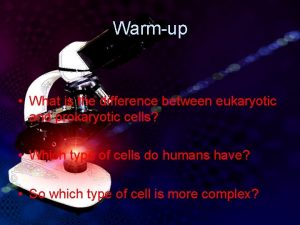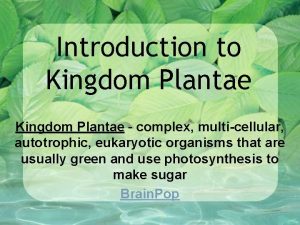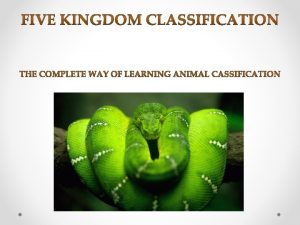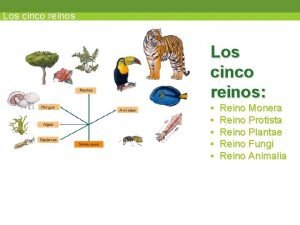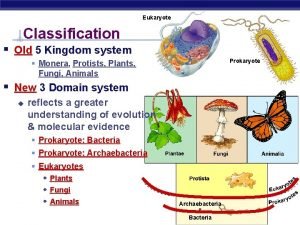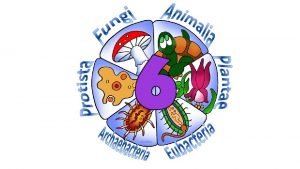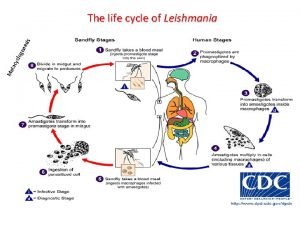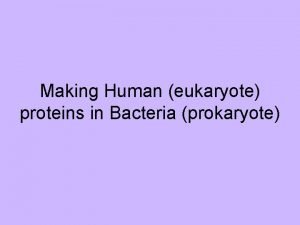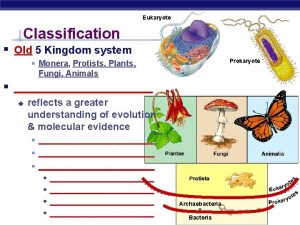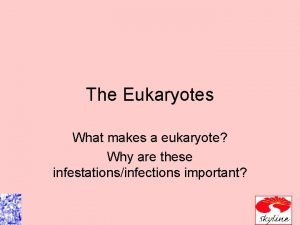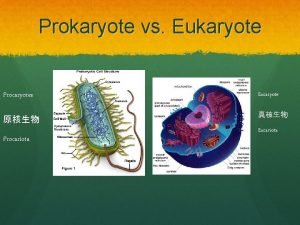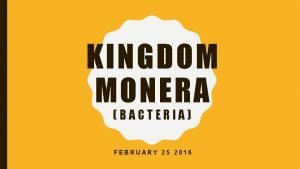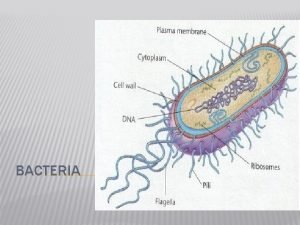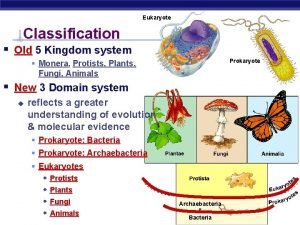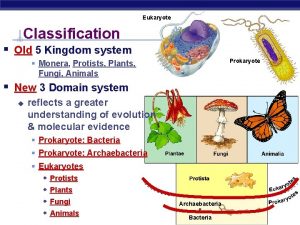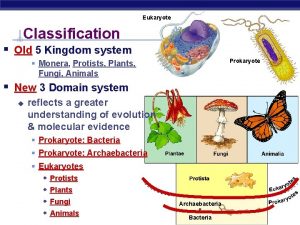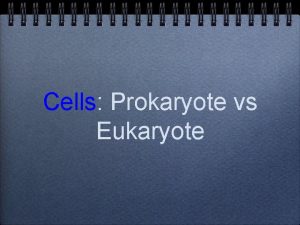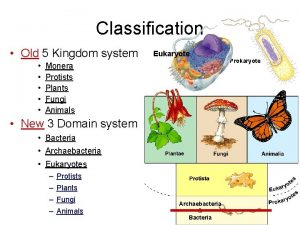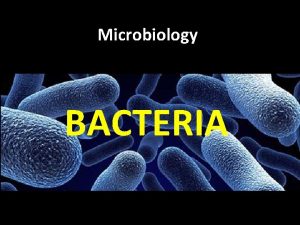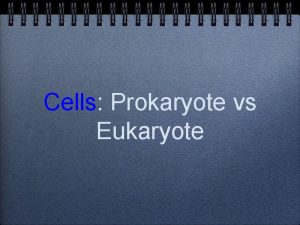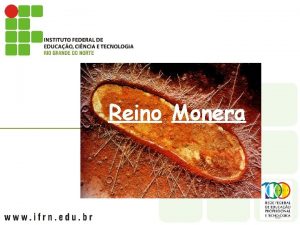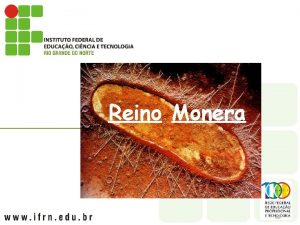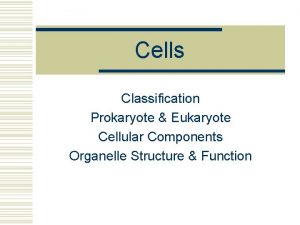Eukaryote Classification Old 5 Kingdom system Prokaryote Monera





















- Slides: 21

Eukaryote Classification § Old 5 Kingdom system Prokaryote § Monera, Protists, Plants, Fungi, Animals § New 3 Domain system u reflects a greater understanding of evolution & molecular evidence § Prokaryote: Bacteria § Prokaryote: Archaebacteria § Eukaryotes w Plants w Fungi w Animals AP Biology Archaebacteria & Bacteria

Kingdom Bacteria Kingdom AP Biology. Fungi Kingdom Archaebacteria Kingdom Protist Kingdom Plant Kingdom Animal

Prokaryotes Domain Bacteria Domain Archaebacteria Domain Bacteria AP Biology Domain Archaea Domain Eukarya 2007 -2008 Common ancestor

Phylogeny of Prokaryotes AP Biology

Domain Archaea § Prokaryotes are extremophiles (love extreme conditions u u extreme halophiles (salt loving) halobacterium extreme thermophiles (heat loving) sulfolobus Methanogens—release methane as by-product Archaea clads include: § § AP Biology Euryarchaeota—extreme halophiles & methanogens Crenarchaeota—hydrothermal springs Korarchaeota—young species, small Nanoarchaeota—dwarf prokaryote, small genome

Domain Bacteria § Proteobacteria: Gram Negative prokaryotes: Alpha, Beta, § § Gamma, Delta, Epsilon Chlamydias: STD’s, gram negative Spirochets: gram negative, spiral motility Cyanobacteria: plantlike, O 2 generating photosynthesis Gram Positive Bacteria: anthrax, botulism, staph & strep AP Biology

Bacteria live EVERYWHERE! § Bacteria live in all ecosystems on plants & animals u in the soil u in depths of the oceans Microbes always u in extreme cold find a way to make a living! u in extreme hot u in extreme salt u on the living u on the dead u AP Biology

Bacterial diversity rods and spheres and spirals… Oh My! AP Biology

eukaryote cell Prokaryote Structure § Unicellular u prokaryote cell bacilli, cocci, spirilli § Size u 1/10 size of eukaryote cell § 1 micron (1 um) § Internal structure u u AP Biology no internal compartments § no membrane-bound organelles § only ribosomes circular chromosome-Plasmids, naked DNA § not wrapped around proteins

Prokaryote vs. Eukaryote Chromosome Prokaryote Eukaryote double helix AP Biology

mitochondria Variations in Cell Interior cyanobacterium (photosythetic) bacterium aerobic bacterium chloroplast inter na for p l memb rane hoto s s like a ch ynthesis (thyl loroplas t akoi ds) AP Biology nes a r b em m l a on n i t r a e t r i in sp ion e r r d r n fo cho o t i m a e) e a t k s li i (cr

Prokaryote Cell Wall Structure Gram-positive bacteria peptide side chains cell wall peptidoglycan plasma membrane That’s important for your doctor to know! protein peptidoglycan = polysaccharides + amino acid chains lipopolysaccharides = lipids + polysaccharides Gram-negative bacteria cell wall outer membrane of lipopolysaccharides outer membrane peptidoglycan AP Biology plasma membrane

Prokaryote Cell Surface Structures § Capsule: cell wall surrounded by sticky layer of § polysaccharide or protein. Adheres to substrate or other individuals in colony. Also protects against dehydration and attacks by host’s immune system. Endospores: a tough multilayered structure. Forms around copy of chromosome. Protective coat helps to survive for years in the soil. Stays dormant. § Flagellum: used for taxis and motility. Not related, analogous structures, arose independently. § Fimbriae: hairlike appendages help prokaryote attach to surfaces or to other cells. § Sex pili: appendages that pull two cells together prior to DNA transfer from one cell to the other cell. AP Biology

Prokaryotic metabolism § How do bacteria acquire their energy & nutrients? u photoautotrophs § photosynthetic bacteria u chemoautotrophs § oxidize inorganic compounds w nitrogen, sulfur, hydrogen… u Photo/chemo heterotrophs § live on plant & animal matter § decomposers & pathogens AP Biology

Genetic Diversity in Prokaryotes § Rapid Reproduction: Prokaryotes are small, reproduce by binary fission, and have short generation times. Example, e-coli in intestines. u AP Biology Bacteria reproduce every 20 minutes. 1=2, 2=4, 4=8, 8=16, 16=32, 32=64, and so forth. Large populations, trillions of individuals, far more than populations of multicellular eukaryotes.

Genetic variation in bacteria § Mutations u error rate in copying DNA § 1 in every 200 bacteria has a mutation § 9 million mutations per day per human host § you have billions of E. coli in your gut! w lots of mutation potential! § Genetic Recombination u u AP Biology Combining of DNA from two sources DNA swap genes, switch alleles, cross over § Transformation--cells uptake foreign DNA from its surroundings. Exchanges alleles. § Transduction—bacteriophage injects DNA into cell and crossing over takes place.

Genetic variation in bacteria • Genetic Recombination continued: Conjugation—DNA is transferred between two prokaryotic cells that are temporarily joined by the sex pilus. DNA passes through the hollow pilus. Conjugation is the direct method for passing and mixing up DNA between two prokaryotic cells. AP Biology

Prokaryotes in the biosphere § If Prokaryotes disappeared, we would disappear also. We are dependent on Prokaryotes. u u Prokaryotes are decomposers, unlocking C & N Some produce O 2, use CO 2 to make sugar Prokaryotes fix atmospheric N 2 into nitrogen Ecological Interactions § Symbiotic relationships: § mutualism, commensalism, & parasitism AP Biology

Bacteria as pathogens § Disease-causing microbes u plant diseases § wilts, fruit rot, blights u animal diseases § § § § AP Biology tooth decay, ulcers anthrax, botulism plague, leprosy, “flesh-eating” disease STDs: gonorrhea, chlamydia typhoid, cholera TB, pneumonia lyme disease

Bacteria as beneficial (& necessary) § Life on Earth is dependent on bacteria u decomposers § recycling of nutrients from dead to living u nitrogen fixation § only organisms that can fix N from atmosphere w needed for synthesis of proteins & nucleic acids w plant root nodules u help in digestion (E. coli) § digest cellulose for herbivores w cellulase enzyme § produce vitamins K & B 12 for humans u produce foods & medicines § from yogurt to insulin AP Biology

Got any Questions? ? Ask da’ Boss! AP Biology 2017 -2018
 Eukaryote prokaryote difference
Eukaryote prokaryote difference Is protist a prokaryote or eukaryote
Is protist a prokaryote or eukaryote Eukaryotic vs prokaryotic
Eukaryotic vs prokaryotic Prokaryotic cells do not have
Prokaryotic cells do not have Old kingdom middle kingdom new kingdom
Old kingdom middle kingdom new kingdom Old kingdom middle kingdom new kingdom
Old kingdom middle kingdom new kingdom Old kingdom middle kingdom new kingdom
Old kingdom middle kingdom new kingdom Mentohotep
Mentohotep A multicellular autotrophic organism with vascular tissue
A multicellular autotrophic organism with vascular tissue Protista
Protista Representante del reino mónera.
Representante del reino mónera. Protist vs archaea
Protist vs archaea Prokaryote unicellular
Prokaryote unicellular Ycl coding
Ycl coding Eukaryote
Eukaryote Eukaryote
Eukaryote What makes something a eukaryote
What makes something a eukaryote Sentence for eukaryote
Sentence for eukaryote Procariota organelas
Procariota organelas Monera kingdom reproduction
Monera kingdom reproduction Monera kingdom reproduction
Monera kingdom reproduction Kingdom monera eubacteria
Kingdom monera eubacteria
